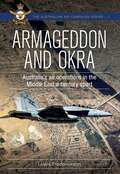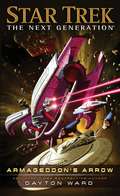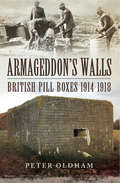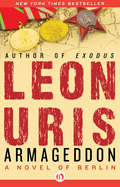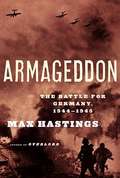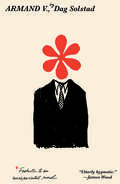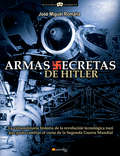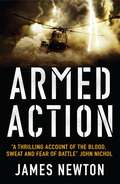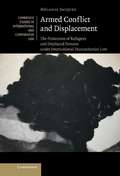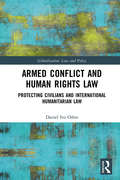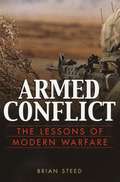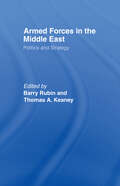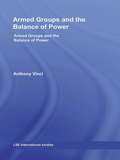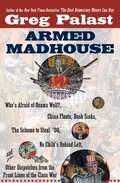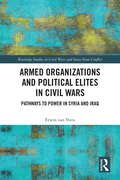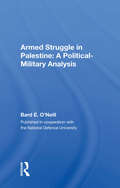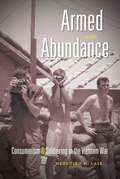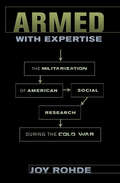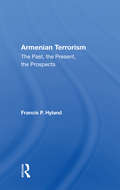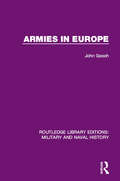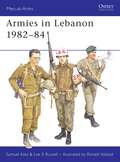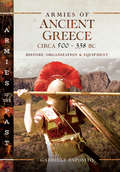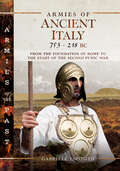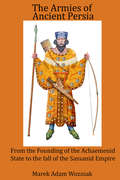- Table View
- List View
Armageddon and OKRA: Australia's air operations in the Middle East a century apart (Australian Air Campaign Series #1)
by Lewis FredericksonThe dispatch of an Ottoman Army by Australian-led Imperial air power in the Wadi Fara on 21 September 1918 occurred just five years after the advent of military aviation in Australia. In 1914, the fledgling Australian air service operated the flimsy Bristol Boxkite; four years later it was flying the far more advanced Bristol F2B Fighter. This leap forward represented a profound progress in technology that has typified the technical development of aviation, particularly in Australia ever since. Ironically, on 21 September 2014, 96 years after the events of the Wadi Fara, Australian squadrons were again deployed to the same part of the world where they would remain for more than three years on operations against extremist terrorism. Armageddon and OKRA contrasts these events, a century apart, in the context of the development of Australian air power. The book tracks the history where Australia has maintained a balanced air service compelling high technical, logistics and engineering standards, and effective training and command and control systems, for more than 100 years. These processes were as applicable a century ago as they are today. By examining these operational events, the author establishes the connection that access to the technology associated with air power is intrinsically linked to Australia&’s enduring foreign and defence policy – more so, that military power is a means to an end, and never an end unto itself.
Armageddon's Arrow: Armageddon's Arrow (Star Trek: The Next Generation)
by Dayton WardAn all-new novel of The Next Generation expanded universe from the New York Times bestselling author!It is a new age of exploration, and the USS Enterprise is dispatched to &“the Odyssean Pass,&” a region charted only by unmanned probes and believed to contain numerous inhabited worlds. Approaching a star system with two such planets, Captain Jean-Luc Picard and his crew find a massive alien vessel, drifting in interstellar space for decades. Sensors detect life aboard the derelict—aliens held in suspended animation. Thought to be an immense sleeper ship, the vessel actually is a weapon capable of destroying entire worlds...the final gambit in a war that has raged for generations across the nearby system. Captain Picard is now caught in the middle of this conflict and attempts to mediate, as both sides want this doomsday weapon…which was sent from the future with the sole purpose of ending the interplanetary war before it even began!
Armageddon's Walls: British Pill Boxes, 1914–1918
by Peter OldhamThe British Army and her commonwealth Allies went to war in 1914 with little knowledge and experience of constructing permanent, shell proof protective structures. Some masonry fortifications, such as defensive blockhouses in South Africa, had been built but the Royal Engineers of the Army were more versed in simple temporary defences suitable for mobile warfare. Home defences were a limited number of forts around naval ports, and Martello Towers on the east coast. It was considered that the Navy was quite able to defend Britain's coasts.The Germans, on the other hand, as with the other continental countries such as France, Belgium, Italy, Holland, Poland, Austria, etc. had been constantly renewing and updating border forts for several centuries. They had also maintained fortification and siege elements of their armies, who were experienced in designing and constructing strong shelters. Both German and French armies began the war with a degree of expertise in what was to become a static war with little movement. However, by 1918 the British were to surpass both enemy and her allies in the design and construction, with supply and logistics, of such shell proof cover for troops and defensive positions.This book gives the history of development and innovation of concrete bunkers, pill boxes, blockhouses and general concrete constructions during the First World War. Many of these structures some showing obvious signs of war damage - still exist in France and Belgium today.All the existing structures, with photograph (except for some which are impractical, because of dense vegetation,) are shown within. Many entries have contemporary maps showing how they fitted into a defensive system, whilst for others the location can be identified from the text. GPS coordinates are given for each entry, except for a few which are on private land and where privacy has been requested.
Armageddon: A Novel Of Berlin
by Leon UrisIn Berlin at the end of World War II, an American Army officer bears witness to the aftermath of one historic tragedy and the rise of another. Captain Sean O'Sullivan distinguishes himself as a courageous soldier in the closing days of World War II, but what comes next tests his deepest reserves of strength and conviction. Sent to oversee the rebuilding of Berlin, O'Sullivan is exposed to the horrific truths of the Holocaust, a shattered and defeated society, and the new threat of Soviet power as the Iron Curtain begins to shadow the city. When Soviet forces blockade Berlin and the airlift begins, O'Sullivan is faced with profound moral dilemmas in an increasingly complicated world. Armageddon is one of the great fictional portrayals of Europe in the earliest days of the Cold War.
Armageddon: The Battle for Germany, 1944-45
by Max HastingsIn September 1944, the Allies believed that Hitler's army was beaten and expected the bloodshed to end by Christmas. Yet a series of mistakes and setbacks, including the Battle of the Bulge, drastically altered this timetable and led to eight more months of brutal fighting. With Armageddon, the eminent military historian Max Hastings gives us memorable accounts of the great battles and captures their human impact on soldiers and civilians. He tells the story of both the Eastern and Western Fronts, raising provocative questions and offering vivid portraits of the great leaders. This rousing and revelatory chronicle brings to life the crucial final months of the twentieth century's greatest global conflict.From the Trade Paperback edition.
Armand V
by Steven T. Murray Dag SolstadNew Directions proudly introduces two novels in English by the Norwegian master, who is “without question, Norway’s bravest, most intelligent novelist” (Per Petterson) Armand is a diplomat rising through the ranks of the Norwegian foreign office, but he’s caught between his public duty to support foreign wars in the Middle East and his private disdain for Western intervention. He hides behind knowing, ironic statements, which no one grasps and which change nothing. Armand’s son joins the Norwegian SAS to fight in the Middle East, despite being specifically warned against such a move by his father, and this leads to catastrophic, heartbreaking consequences. Told exclusively in footnotes to an unwritten book, this is Solstad’s radically unconventional novel about how we experience the passing of time: how it fragments, drifts, quickens, and how single moments can define a life.
Armas secretas de Hitler (Historia Incógnita)
by Miguel José RomañaDurante los dos últimos años de la Segunda Guerra Mundial, los avances tecnológicos logrados por Alemania fueron sorprendentes. Junto a aviones a reacción de los más variados y vanguardistas diseños, llegaron las aeronaves discoidales de prestaciones nunca imaginadas. A ello se unieron “armas maravillosas” como misiles para cualquier acción bélica, increíbles “bolas de fuego”, submarinos indetectables, cañones sónicos y eléctricos, la bomba endotérmica, y un largo etcétera de armamento prodigioso.
Armed Action
by James Newton, Dfc'I couldn't see the tank. I couldn't see it... Someone was screaming over the radio. "Scream all you want, I still can't see it," I said to my pilot. The next explosion was so close it lifted my chest armour off my body in the shock wave. The noise brought me back to my awful reality. I looked out of the sight to see the shattered cockpit glass. The next one would be it and we knew it.' Lieutenant Commander James Newton survived and was awarded the Distinguished Flying Cross for his bravery. In a career that has seen him on operations over Bosnia, Sierra Leone, Northern Ireland and most recently Iraq, Newton is no stranger to being shot at. He has flown all the aircraft the Navy has and even ones it doesn't. Thrilling, fast-paced and an adrenaline-fuelled adventure, Armed Action is a fascinating insight into life in the air.
Armed Conflict and Displacement
by Mélanie JacquesWith 'displacement' as the guiding thread, the purpose of this study is twofold. Firstly, it derives from the relevant provisions of international humanitarian law a legal framework for the protection of displaced persons in armed conflict, both from and during displacement. It contains a case study on Israeli settlements in the Occupied Palestinian Territory and the recent Advisory Opinion on the Separation Wall, and addresses such issues as humanitarian assistance for displaced persons, the treatment of refugees in the hands of a party to a conflict and the militarisation of refugee camps. Secondly, it examines the issue of displacement within the broader context of civilian war victims and identifies and addresses the normative gaps of international humanitarian law, including the inadequacy of concepts such as 'protected persons' and the persistence of the dichotomy between international and non-international armed conflicts, which is at odds with the realities of contemporary armed conflicts.
Armed Conflict and Human Rights Law: Protecting Civilians and International Humanitarian Law (Globalization: Law and Policy)
by Daniel Ivo OdonThis book explores developments in international law regarding the relationship between human rights law and international humanitarian law and their coapplicability in armed conflict situations. The work examines the jurisprudence of the international human rights courts and looks at the Inter-American and European Courts of Human Rights case law in dealing with new emergencies in armed conflicts. It argues that a new interpretation and application of the law is required to deal with current needs while remaining faithful to moral commitments made in the international arena. In this way, the book deals with recent cases and their rationale to build a new understanding of law and international policy that complies with the globalization process and progress towards an enhancement of the international community’s legal framework. Combining the emergencies in armed conflicts with the mutual enforcement of human rights law and humanitarian law, this book holistically develops concepts and theories to present a pragmatic solution to moral quandaries over the targeting of civilians during armed conflict situations. The book will be a valuable resource for academics, researchers and policy-makers in the areas of international human rights and international humanitarian law.
Armed Conflict: The Lessons of Modern Warfare
by Brian SteedWhat challenges will America face in armed conflicts of the future and how will we prepare for them? National security depends upon the ability of the military to predicto the future nature of war. Despite the difficulty in making such predictions, one must remember: nation states and other countries will continue to use armed conflict as a means to further their aims, and these aims will, at times, run contrary to American interests. As a result, the United States will continue to be confronted with armed conflict in the days and years ahead. A military theorist and experienced armor officer, Brian Steed provides insights into the future of armed conflict by focusing on what has occurred in the pastunot because the past repeats itself, but because it reveals timeless principles of warfare. Five battles, one each in Korea, Vietnam, the Falklands, the Persian Gulf, and Somalia are analyzed historically, geographically, and strategically. Steed's analysis of these engagements clearly demonstrates that the key to victory on the battlefields of the future is the small unit. In refreshing layman's prose, the author focuses on why the events occurred as they did, and explores the significance of each battle in terms of its political and military ramifications. He concludes with lessons learned that will greatly benefit future American ground combat commanders. Armed Conflict informs the reader about the historical trends of combat operations and the realities of warutoday and into the future. It will also serve to guide a new generation of military and civilian leaders as they prepare to face the inevitable conflicts in the new century.
Armed Forces in the Middle East: Politics and Strategy (Besa Studies In International Security)
by Barry Rubin Thomas A. KeaneyAn examination of the Middle East's leading armed forces and their role in both military and political affairs. The book considers their missions, doctrine, training, equipment and effectiveness as fighting forces.
Armed Groups and the Balance of Power: The International Relations of Terrorists, Warlords and Insurgents (LSE International Studies Series)
by Anthony VinciThis new book provides a framework for understanding the international relations of armed groups, including terrorist organizations, insurgencies and warlords, which play an increasingly important role in the international system. Specifically, the book argues that such groups can be understood as taking part in the balance of power with states and other armed groups, as they are empirically sovereign non-state actors that are motivated by the pursuit of power and exist as part of an anarchic, self-help system. This radically new approach offers a renewed conceptualization of Neorealism, and provides new insights into debates about sovereignty, non-state actors, new wars, counterterrorism, and counterinsurgency. The approach is illustrated through case studies on Somali warlords, the security complex between the Lord’s Resistance Army (LRA), Sudanese People’s Liberation Army (SPLA), Sudan and Uganda, as well as Al Qaeda. The book provides insights into such issues as how non-state actors can be integrated into structural theories of international relations, and also offers pragmatic methodologies for the foreign policy or military practitioner, such as how to best deter terrorists.
Armed Madhouse
by Greg Palast(From the book jacket) Greg's most provocative and caustically funny book yet, Armed Madhouse brings you the stories not allowed in The New York Times. Armed with more than fifty classified documents, confidential memos, and secret plans liberated from the Pentagon, FBI, World Bank, and ExxonMobil, Palast cuts through the TV news babytalk: Before invading, George Bush didn't have a secret plan to seize Iraq's oil-he had two. Palast shows you both. In "Who's Afraid of Osama Wolf?," Palast reveals the horror and humor of the War on Terror. In "The Network," Palast gives you the skinny on the new global order-and pushes Thomas Friedman over the edge of his Flat World. It was Palast, for BBC TV, who first uncovered how Jeb Bush and Katherine Harris stole Election 2000. Here he's got a new twist: Palast tells you that Kerry won in 2004-and that 2008 is already fixed.
Armed Organizations and Political Elites in Civil Wars: Pathways to Power in Syria and Iraq (Routledge Studies in Civil Wars and Intra-State Conflict)
by Erwin van VeenThis book analyses under what conditions, and with what developmental effects, armed organizations shift their ‘coercive profile’ during civil wars, with a focus on the recent conflicts in Syria and Iraq.The work begins with an operationalisation of the term ‘political settlement’, focusing on how power is organized in fragile and conflict-affected countries, and then uses this operationalization to analyse the political settlements of contemporary Syria and Iraq, including their breakdown and transformation during recent civil wars (of 2011-today in Syria and 2014-17 in Iraq). It subsequently examines why and how elite factions have used armed organizations in times of conflict. This approach links an understanding of the broad evolution of power relations at the national level with the specific effects of the use of armed organizations on such relations. It argues for a shift from assigning fixed labels to armed organizations during civil wars to studying their coercive profile in a dynamic fashion, i.e. how armed organizations behave in terms of their use of threats and coercive force. The book introduces five profiles of coercive behaviour that demonstrate how the same organization can behave very differently at various points in time. One of these, the ‘hybrid coercive profile’, fills a gap in the existing civil war typology of organized armed violence by opening up the possibility of elite factions deliberately combining collaborative and competitive modes of behaviour. As an evidence base, the book provides in-depth analysis of the origins, evolution and operations of four armed organizations that have acted under a hybrid coercive profile during the Syrian and Iraqi civil wars: the Syrian Kurdish People’s Defence Forces, the Eagles of the Whirlwind of the Syrian Social Nationalist Party, the Iraqi Kurdish Peshmerga and the Badr Organization. By connecting the concepts of political settlement and civil war, and applying them to specific armed organizations operating in Syria and Iraq, the book offers new insights into this nexus.This book will be of much interest to students of civil wars, conflict studies, Middle Eastern Studies and International Relations.
Armed Struggle In Palestine: A Political-military Analysis
by Bard E. O'neillBard O'Neill investigates the Palestinian guerrilla movement and assesses the probability that the fedayeen will achieve their aim of liberating Palestine-including Israel-by means of protracted revolutionary insurgency. His analytic framework incorporates several factors that have a critical bearing on the outcomes of protracted insurgencies; thes
Armed with Abundance
by Meredith H. LairPopular representations of the Vietnam War tend to emphasize violence, deprivation, and trauma. By contrast, in Armed with Abundance, Meredith Lair focuses on the noncombat experiences of U.S. soldiers in Vietnam, redrawing the landscape of the war so that swimming pools, ice cream, visits from celebrities, and other "comforts" share the frame with combat.To address a tenuous morale situation, military authorities, Lair reveals, wielded abundance to insulate soldiers--and, by extension, the American public--from boredom and deprivation, making the project of war perhaps easier and certainly more palatable. The result was dozens of overbuilt bases in South Vietnam that grew more elaborate as the war dragged on. Relying on memoirs, military documents, and G.I. newspapers, Lair finds that consumption and satiety, rather than privation and sacrifice, defined most soldiers' Vietnam deployments. Abundance quarantined the U.S. occupation force from the impoverished people it ostensibly had come to liberate, undermining efforts to win Vietnamese "hearts and minds" and burdening veterans with disappointment that their wartime service did not measure up to public expectations. With an epilogue that finds a similar paradigm at work in Iraq, Armed with Abundance offers a unique and provocative perspective on modern American warfare.
Armed with Expertise: The Militarization of American Social Research during the Cold War (American Institutions and Society)
by Joy RohdeDuring the height of the wars in Iraq and Afghanistan, the Pentagon launched a controversial counterinsurgency program called the Human Terrain System. The program embedded social scientists within military units to provide commanders with information about the cultures and grievances of local populations. Yet the controversy it inspired was not new. Decades earlier, similar national security concerns brought the Department of Defense and American social scientists together in the search for intellectual weapons that could combat the spread of communism during the Cold War. In Armed with Expertise, Joy Rohde traces the optimistic rise, anguished fall, and surprising rebirth of Cold War–era military-sponsored social research.Seeking expert knowledge that would enable the United States to contain communism, the Pentagon turned to social scientists. Beginning in the 1950s, political scientists, social psychologists, and anthropologists optimistically applied their expertise to military problems, convinced that their work would enhance democracy around the world. As Rohde shows, by the late 1960s, a growing number of scholars and activists condemned Pentagon-funded social scientists as handmaidens of a technocratic warfare state and sought to eliminate military-sponsored research from American intellectual life.But the Pentagon's social research projects had remarkable institutional momentum and intellectual flexibility. Instead of severing their ties to the military, the Pentagon’s experts relocated to a burgeoning network of private consulting agencies and for-profit research offices. Now shielded from public scrutiny, they continued to influence national security affairs. They also diversified their portfolios to include the study of domestic problems, including urban violence and racial conflict. In examining the controversies over Cold War social science, Rohde reveals the persistent militarization of American political and intellectual life, a phenomenon that continues to raise grave questions about the relationship between expert knowledge and American democracy.
Armenian Genocide: The Great Crime of World War I (History of Terror)
by David CharlwoodThis short history sheds light on the slaughter and expulsion of ethnic Armenians during WWI with stories of those who witnesses the terror firsthand. Twenty years before the start of Hitler&’s Holocaust, over 1.5 million Armenians were murdered by the Turkish state. They were crammed into cattle trucks and deported to camps, shot and buried in mass graves, or force-marched to death. It was described as a crime against humanity and Turkey was condemned by Russia, France, Great Britain and the United States. But two decades later the genocide had been conveniently forgotten. Hitler justified his Polish death squads by asking in 1939: &‘Who after all is today speaking about the destruction of the Armenians?&’ In Armenian Genocide, historian David Charlwood presents a gripping short history of a forgotten genocide. With vivid eyewitness accounts, this volume recalls the men and women who died, the few who survived, and the diplomats who tried to intervene.
Armenian Terrorism: The Past, The Present, The Prospects
by Francis P HylandArising seemingly out of nowhere, Armenian terrorist groups in the last two decades have carried out over 200 attacks in some two dozen countries around the world. Although this wave of terror at first appears to have sprung up without warning, a closer look at Armenian history, especially since World War I, shows that it is only the most recent in a series of outbreaks of ethnic violence. In this study, the author examines the social and political background of Armenian terrorism and its similarities to and differences from other terrorist movements, and he carefully dissects the organizational methods of these groups. An important feature of the work is an extensive and detailed chronology of Armenian terrorism from 1915 to the present. Each entry provides essential information concerning the date and time of the attack, location, victims, weapons used, terrorist groups and individual commandos responsible for the attack, and a list of sources for further reference. A resource for specialists studying terrorism and ethnic violence, "Armenian Terrorism" should also be useful to those interested in the tragic and difficult history of Armenia and Turkey.
Armies in Europe (Routledge Library Editions: Military and Naval History #14)
by John GoochThis book, originally published in 1980, is a study of the nature and purposes of peace-time military organization in Europe, and of the characteristics and outcome of the major wars fought during these years. It charts the rise of mass armies and the role of conscription as a socializing agent and a military instrument, as well as discussing the growing involvement of society in war both as agent and target of military activity, the mounting effort required of a society in order to ahcieve victory, culminating in the ‘Total War’ of 1939-45. Among other subjects explored are the development of war economies, the genesis and significance of war aims, the importance of social cohesion in modern war and the impact of technology.
Armies in Lebanon 1982-84
by Ronald Volstad Sam KatzThe Lebanese Civil War of 1975-76 caused 80,000 dead and totally split the country along factional lines. An estimated 50 different militias came into existence, and acts of violence were both individual and collective. In the midst of this explosive atmosphere, cross-border conflict between Israel and Lebanon intensified, culminating in Operation Peace for Galilee - the invasion of Lebanon. This book offers a day-by-day account of the invasion and the subsequent siege of Beirut, an operation that resulted in both the PLO and Israel claiming victory. Numerous photographs and colour plates portray the uniforms and equipment of the Israeli, Palestinian and Multi-National forces.
Armies of Ancient Greece Circa 500–338 BC: History, Organization & Equipment (Armies Of The Past Ser.)
by Gabriele EspositoIllustrated with color photos, this guide details the arms, armor, organization, and tactics of Classical Greek armies.The Classical period includes some of the most famous wars and battles of Ancient Greece, including the defeat of the Persians at Marathon, the Spartans’ last stand at Thermopylae, the Peloponnesian War and the March of the Ten Thousand. The Greek heavy infantry spearmen, or hoplites, are one of the most recognizable types of ancient warrior and their tightly-packed phalanx formation dominated the battlefield.Covering the period from the Persian Wars to the Macedonian victory at the Battle of Chaeronea, Gabriele Esposito examines the famous hoplites heavy infantry as well as other troops, such as light infantry skirmishers and cavalry. His clear, informative text is beautifully illustrated with dozens of color photographs showing how the equipment was worn and used.
Armies of Ancient Italy, 753–218 BC: From the Foundation of Rome to the Start of the Second Punic War (Armies of the Past)
by Gabriele EspositoA military history of ancient Italy, featuring details of the weapons, equipment, and tactics, as well as color photos showing how warriors looked.Before becoming the masters of the Mediterranean world, the Romans had first to conquer the Italian peninsula in a series of harsh conflicts against its other varied and warlike residents. The outcome was no foregone conclusion and it took the Romans half a millennium to secure the whole of Italy.In Armies of Ancient Italy 753–218 BC, Gabriele Esposito presents the armies that fought these wars, in which the Roman military spirit and their famous legions were forged. He not only follows the evolution of the Roman forces from the Regal Period to the outbreak of the Second Punic War but also the forces of their neighbors, rivals and enemies. The most notable of these, the Etruscans, Samnites and the Italian Greeks are given particular attention but others, such as the Celts and Ligures of the North and the warriors of Sicily and Sardinia, are also considered. Details of the organization, weapons, equipment and tactics of each army are described, while dozens of beautiful color photos of reenactors show how these warriors looked in the field.“Once more, a beautifully illustrated book, this time starting with the story of Rome from the Regal Period to the Second Punic War. The author follows the highly successful format of his books covering the late period of the Roman Empire.—Most Highly Recommended.” —Firetrench“An interesting look at all the people of the Italian era, but what really brings it to life are the countless full colour photographs of re-enactor groups in the correct armour and dress for the various tribes and regions they represent. Excellent production standards and a fascinating look at the history of early Rome.” —The Armourer
Armies of Ancient Persia: From the Founding of the Achaemendid State to the Fall of the Sassanid Empire
by Marek Adam WozniakThe Armies of Ancient Persia is a translation of Marek Adam Wozniak’s original Polish manuscript detailing the rise and fall of the Persian armies from Cyrus the Great to the fall of the Sasanid Empire. Relying on a wealth of recent archeological evidence and studies, Dr. Wozniak provide a detail picture of the recruitment, organization, armament and battles of one of the largest armies of the ancient world
